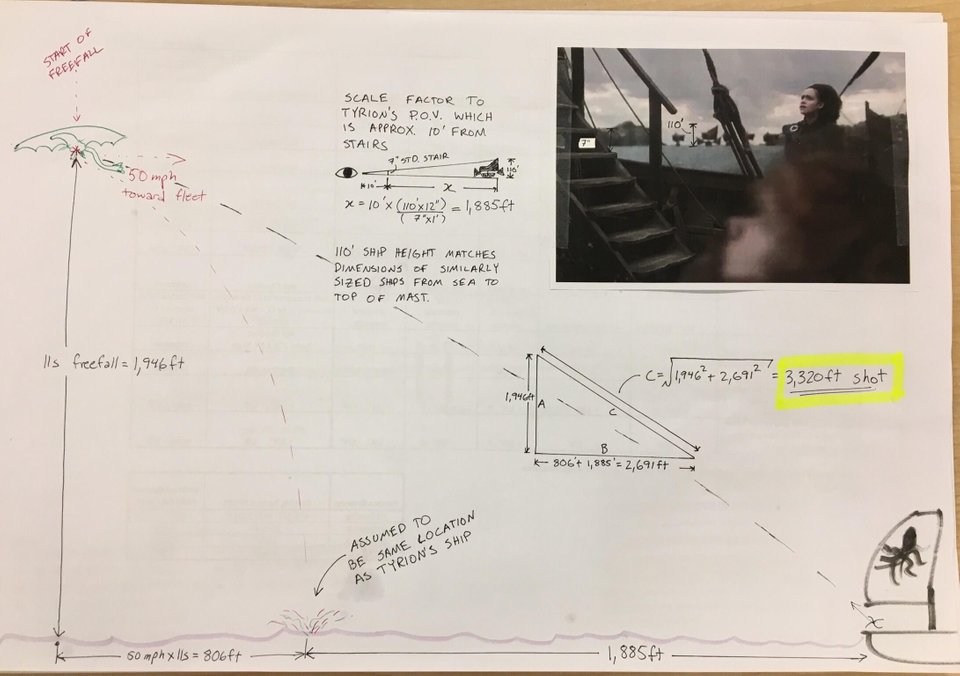The last Game of Thrones episode that we saw isn’t just the worst in season 8 when it comes to IMDB ratings, it’s also the worst in the entire history of Game of Thrones. The Last of the Starks annoyed people for various reasons, as we’ve already explained, but the most important one is the lack of logic in some scenes. The killing of Rhaegal, as spectacular as it might be, is incredibly stupid considering how it was all orchestrated. And some Game of Thrones fans dove into the math and physics of the situation in an effort to explain precisely how stupid it really was.
Before we go into it, let’s watch the entire thing again:
https://www.youtube.com/watch?v=V_v6VINwkEk
That’s a devastating blow to Dany and her army, but it could have played out so much better. It could have been done in a way that made sense, and nobody would have criticized it.
First up, we have Reddit user mikedakwik who created the following drawing to try to explain how high Dany was flying, at what speed, and how far Euron’s fleet was.

He concludes that Euron fired the Scorpion at a distance of approximately 3,320 feet from the target:
According to my calculations, Rhaegal got hit 3x in a row from a distance of approximately 3,320ft (0.628miles), almost exactly one Kilometer.
Sooo… if they could hit the small dragon 3/3 from range, why didn’t Drogon get shot from point blank by a full volley from Euron’s ambush fleet?
- Plot Armor.
- They missed on purpose! Cersei only wanted one dragon killed so that her master plan of having Dany burn the city could play out. At this point, I’m more of the mind that Cersei wants everyone to suffer more than she wants the throne, if that’s true. She wants Dany to turn into the Mad Queen, which can only happen if she has a dragon left to lay fire to King’s Landing.
But wait, it gets a lot better when you look at the entire physics behind firing projectiles at an angle towards a target, and that’s exactly what Michael Livingston did over at Tor.com. Before we get into all of that, here’s a video that reminds you of this particular physics lesson, and you should watch it in order for everything that follows to make sense:
The gist of projectile ballistics is pretty simple. What goes up must come down, because gravity pulls at the projectile while it’s flying through the air. Therefore, the trajectory of the Scorpion “missile” has to look like a parabola, an arc between departure and arrival.
The problem Livingston identified with Euron’s Scorpion bolts is that they went “really straight”:
Since a projectile under the influence of gravity cannot have a flat trajectory, the only explanation for such a seemingly straight shot would be that its parabolic arc is so wide that within the range covered it appears to be flat. It’s rather like how over short distances the Earth appears to be flat, but that’s only because we’re seeing such a small section of a really wide curvature.
After applying numbers to it, Livingston concluded that the bolt would have needed to have an initial velocity of 2,000m/s (4,484 miles per hour) to hit an object moving at 5m/s (11 miles per hour) at a range of 1,000 meters (0.62 miles), at an angle of about 20 degrees.
Any bolt that missed the dragon would have reached a maximum elevation of 14 miles above sea level before returning to Earth. The Scorpion bolt would have been airborne for more than two minutes, during which time it would have traveled some 163 miles. Come to think of it, these Scorpions might have come in handy during the Battle of Winterfell in episode 3.
Of course, there’s a lot of guesswork here, but the science side of things goes a long way to explain why we’re annoyed with that scene. It’s not because we lost a dragon, it’s because it was done so poorly.








